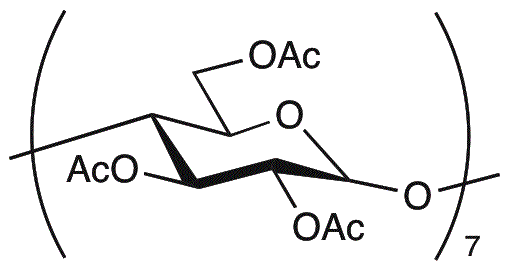Triacetyl-b-cyclodextrin is widely utilized in research focused on:
- Pharmaceutical Formulations: It acts as a drug delivery agent, enhancing the solubility and stability of poorly soluble drugs, which can improve their bioavailability in the body.
- Food Industry: This compound is used as a food additive to encapsulate flavors and nutrients, protecting them from degradation and enhancing their release during consumption.
- Cosmetic Products: It serves as a stabilizer and carrier for active ingredients in cosmetics, ensuring that they remain effective and are delivered properly to the skin.
- Environmental Applications: Triacetyl-b-cyclodextrin can be employed in the remediation of contaminated water by encapsulating pollutants, making them easier to remove from the environment.
- Analytical Chemistry: It is utilized in chromatography as a chiral selector, helping to separate and analyze enantiomers in various chemical samples.
General Information
Properties
Safety and Regulations
Applications
Triacetyl-b-cyclodextrin is widely utilized in research focused on:
- Pharmaceutical Formulations: It acts as a drug delivery agent, enhancing the solubility and stability of poorly soluble drugs, which can improve their bioavailability in the body.
- Food Industry: This compound is used as a food additive to encapsulate flavors and nutrients, protecting them from degradation and enhancing their release during consumption.
- Cosmetic Products: It serves as a stabilizer and carrier for active ingredients in cosmetics, ensuring that they remain effective and are delivered properly to the skin.
- Environmental Applications: Triacetyl-b-cyclodextrin can be employed in the remediation of contaminated water by encapsulating pollutants, making them easier to remove from the environment.
- Analytical Chemistry: It is utilized in chromatography as a chiral selector, helping to separate and analyze enantiomers in various chemical samples.
Documents
Safety Data Sheets (SDS)
The SDS provides comprehensive safety information on handling, storage, and disposal of the product.
Product Specification (PS)
The PS provides a comprehensive breakdown of the product’s properties, including chemical composition, physical state, purity, and storage requirements. It also details acceptable quality ranges and the product's intended applications.
Certificates of Analysis (COA)
Search for Certificates of Analysis (COA) by entering the products Lot Number. Lot and Batch Numbers can be found on a product’s label following the words ‘Lot’ or ‘Batch’.
*Catalog Number
*Lot Number
Certificates Of Origin (COO)
This COO confirms the country where the product was manufactured, and also details the materials and components used in it and whether it is derived from natural, synthetic, or other specific sources. This certificate may be required for customs, trade, and regulatory compliance.
*Catalog Number
*Lot Number
Safety Data Sheets (SDS)
The SDS provides comprehensive safety information on handling, storage, and disposal of the product.
DownloadProduct Specification (PS)
The PS provides a comprehensive breakdown of the product’s properties, including chemical composition, physical state, purity, and storage requirements. It also details acceptable quality ranges and the product's intended applications.
DownloadCertificates of Analysis (COA)
Search for Certificates of Analysis (COA) by entering the products Lot Number. Lot and Batch Numbers can be found on a product’s label following the words ‘Lot’ or ‘Batch’.
*Catalog Number
*Lot Number
Certificates Of Origin (COO)
This COO confirms the country where the product was manufactured, and also details the materials and components used in it and whether it is derived from natural, synthetic, or other specific sources. This certificate may be required for customs, trade, and regulatory compliance.


